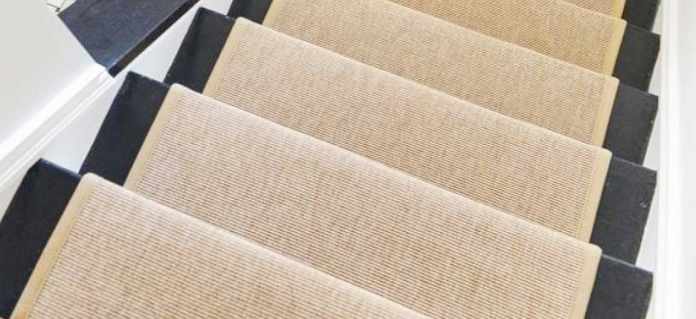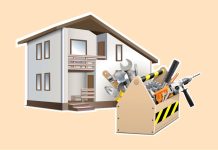Stairs are an essential part of the house. We want every aspect of our house to look good, and that includes stairs as well. We usually use different types and colors of carpets to decorate the stairs. How to measure stairs for carpet
But before using carpets, first, we need to measure the stairs on which we will use them. So that we can figure out how much carpet we need and how much we need to spend.
In this article, we will help you learn how to measure stairs for carpet. We will explain different tips and tricks and the things you need to know how to measure stairs for the rug.
Table of Contents
How to measure stairs for carpet
Unlike measuring a room, measuring stairs is a little bit more complicated. There are different shapes, sizes, and sections of stairs. We need to measure each area- the hallway, the landing, the straight and curved stairs individually.
After that, we need to write down the measurements to do a correct calculation. After taking suggestions from different flooring experts, we came up with a simple guide. We’ve broken it down into simple steps that will help you measure your stairs. So, let’s follow the instructions and learn how to measure stairs for carpet.
Things that you will need to measure stairs
To measure stairs for setting carpets, you will need some basic things. They are:
- Ruler
- Tape measure
- Pen and pencil
- One or two papers
- Calculator
- A helpful advisor or assistant (If you are able to find one)
Things one needs to remember when measuring stairs.
- When you measure stairs, first, only record the actual measurements on your plan. Please don’t add any extra centimeters or allowances because we will do that part later.
- Straight, winder, curved- all of these stairs are slightly different in size and shape. So, we must make sure to measure each of them individually.
- Always start measuring from the top of the stairs to the bottom. Don’t do the opposite because that is the way the pile direction will go.
- Make sure to measure the depth and width of the doorways of your hallway and landing as well. After measuring them, jot down the information you took on your papers. Also, make sure to measure any drop-backs on the hallway and landing.
- Some walls beside the hallway and landing do not turn out to be parallel. So, take a few measurements wall to wall across the hallway and landing.
- If you still face problems in measuring your stairs, take pictures of them. Then find a flooring expert to see them and take advice to find more information in detail.
How to measure stairs
The best way of starting the measurements is, to begin with, the landing. Start from the top, then work down to the bottom and finish with the hallway. After completing it, your plan will include a landing sketch, individual stair measurements, and a hallway sketch. So, without further delay, let’s start measuring.
- Start by measuring the landing
- First, take a paper and draw a floor plan of your landing and hallway. Then mark the place with an arrow where the stairs come down from the dock.
Top tip: Do a double check to make sure this information is included in the plan. It is essential to make sure that the carpet roll goes in the right direction.
- Now measure the landing as you would measure a standard room, remembering to go into any doorways. If necessary, use this guide on how to measure space to help you.
Top tip: The part of the stair on which you place your foot is called a “Tread.” The edge of the step is called a “Nose,” and the vertical part is called a “Riser.”
- Make sure to include the top stairs in the landing plan measurements. Start measuring from the wall or doorway opposite the top step. Then run the tape measure from the nose of the top stair to all the down to the tread. It is essential to do this in one measurement because the carpet needs to run down from the top stair in one piece without a flip. After that, the rest of the stairs will run down in the same direction.
- Measuring the stairs between the landing and the hallway
After measuring the landing, you can start counting the rest of the stairs. To do that, first, you need to find out how many stairs you have. Then you need to make a list of how many straight stairs and how many winders you have. All winders are different in size, and so you need to measure them individually. Measure them as many times as you have to get an accurate number. Be sure to record only the actual measurements on your plan. An example is given below:
7 straight stairs – 0.45 m X 0.90 m wide
W1- 0.80 m X 1.1 m wide
W2 – 0.90 m X 1.2 m wide
W3 – 0.85 m X 1.0 m wide
- Measuring straight stairs: Start your measurement from the back of the top riser, over the nose, towards down to the back of the next tread.
Riser: The riser is the place where the stairs meet the previous step.
Nose: The nose refers to the edge of the stage.
Tread: The place where the stairs meet the next step.
- Measuring half landing: If there is a half landing, first measure the width across the half landing. After that, measure the length of the half landing. Measure the length, including the drop over and down of step to the back of the next tread.
- Measuring curved stairs or winders: When you measure curved stairs, measure each of them individually. The carpet’s pile direction needs to go at a right angle over the nose of the stair.
So, start measuring from the back of the stair tread, over the nose, towards down the riser of the stair to the next track. By doing this, you can easily measure the length of curved stairs. After that, record the measurements in your plan.
In the case of width, start measuring from the inner corner on the narrow ledge to the broadest edge’s furthest point.
In the case of winders, don’t measure just one stair-like straight stairs for the measurement of the rest of the stairs. Be sure to measure each of the stairs individually. Repeat the calculation as many times as you need, and then note down the actual numbers.
- Measuring the hallway
It is almost the same as measuring a landing of the stairs. First, draw a floor plan of the hallway. Then measure the hallway in precisely the same way you would measure your room. Remember to go inside of all alcoves, doorways, and drop-backs. Also, remember to take a few measurements from wall to wall since all the walls aren’t parallel.
After taking all the measurements, draw an arrow on the floor plan. This arrow will show the place where the stairs enter the hallway. This is really helpful in indicating the pile direction of the carpet.
Things related to measuring stairs for carpets
- Measuring hallways
When you are taking measurements for stairs, you have to measure hallways as well. They aren’t always straightforward to measure and also do come in various shapes and sizes.
You might find the absence of inverted halls or awkward L-shaped and T-shaped halls in your house. So, we suggest you measure a hallway just like you would measure a standard room. Record the width and length and also take any alcoves or recesses into account.
Always remember to add extra 10 centimeters to your total length and width measurements. It will allow for any deviations in the wall. It will also help in cutting off the different carpet after fitting it in the room. But keep in mind that a lot of rooms are not square in shape. So, adding just 10 cm to the total calculation might not be enough.
- Measuring a landing
When measuring a landing area for carpet, it is essential to note some things. Such as the measurements will need to include the top step of the stairs and the landing. The reason behind it is that the landing carpet flows over the top step seamlessly into the stairs once fitted.
For measuring a standard room, you can first sketch a plan of the landing area. To make sure that you included all sizes, including doorways and recesses.
To measure a landing, first, stand on the top step. Then mark on your plan where the dock meets the stairs. After that, measure the width and the length of the area. Include the height and width of the top step in the measurements as well. Later, multiply both of the measures to calculate how much carpet you will need.
- Measuring a Mid-landing
You can measure a mid-landing the same way you measure a normal landing area. It is essential that your mid-landing carpet fits over the top step (beneath) in one piece.
So, you will need to measure the mid-landing length and width, also, including the height and width of the top step.
Always remember to add extra 10 centimeters to your total length and width measurements. It will allow for any deviations in the wall. It will also help in cutting off the different carpet after fitting it in the room.
But keep in mind that a lot of rooms are not square in shape. So, adding just 10 cm to the total calculation might not be enough.
Measuring different types of stairs
- Box stairs: When measuring stairs, first, you need to check to make sure they are the same width. Box stairs are the simplest version of stairs. They are also known as straight stairs that have the same width.
After confirming they are the same width, start measuring the tread (depth) and riser (height). The riser is the length vertically up the step, and the track is the length vertically over the stage. Multiply the numbers to find out the total length of the stairs.
After finding the total length, multiply the number with the width. After that, multiply the measurement by the number of stairs to find out how much carpet you need for your stairs.
Note: This process is for measuring the stairs which have the same type of shape.
- Curved stairs: Some of the steps might be different in size and shape. These types of stairs are generally known as curved stairs or winders. To measure them, you cannot follow the same procedure as measuring box stairs.
You need the repeat the measuring process for each one of them. After that, you can record the total size of all the steps together in your plan.
If you have a winding or corner staircase, then first measure the length the same way as a straight staircase. Measure the riser and tread and then multiply them to figure out the total length.
As for the width, measure the widest part of the stairs. The widest part can be the edge or the middle or back of the step. This calculation will depend on how the stairs are fitted at the beginning.
After figuring the width multiply it with the length to find out the total measurement. This way, you can find out how much carpet you need for your curved stairs.
- Bullnose step: A bullnose step is curved at the edge and broader than the rest of the stairs. This curved-shaped step is usually the last step on a staircase. Not all the stairs have this odd shape. But just in case you need to measure one, follow the instructions below:
First, measure the length of the last step along with the straight stairs. After that, wrap a tape measure around the whole curve area and record the width. Then multiply it with the length to find out the total measurement.
Conclusion:
In this article, we have explained the process of how to measure stairs for carpet. We hope you have learned a lot about how to measure stairs for rug after reading it. But if you still have problems with how to measure stairs for carpet, then take a professional’s help.








